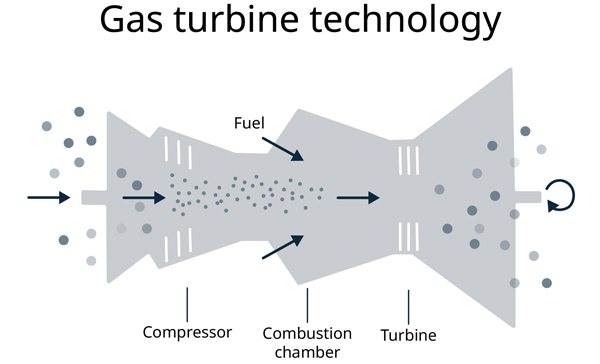

Combustion engine vs. Aeroderivative gas turbine - Introduction
Flexibility in power generation is necessary to support the growing amount of renewables. Let’s take a more thorough look at the challenges faced by the rapidly changing energy landscape and the solutions available to address them. A major energy transition is underway as countries and regions decarbonise their power systems, while electricity demand continues to grow. While large amounts of renewable energy are being added to power systems worldwide, the intermittent nature of renewable energy sources means they do not provide constant power and so cannot meet the demand for energy alone.

The challenge of balancing
Power systems with a high level of renewables require fast-responding, flexible resources to ensure a constant supply of electricity. This is also why traditional baseload power plants’ running hours are dropping, because they cannot balance the continuously changing demand.
Power systems are complex beasts comprising multiple assets. The increasing penetration of renewable energy sources makes it challenging for system operators to maintain a reliable supply due to the intermittency of wind and solar power.

To date, this variability has been mitigated with redundant generating capacity such as gas and coal-powered units operating at part load to enable a fast response to changes in demand. Flexible power generation that can quickly be brought online reduces the inefficiency of relying on part-load operation.
Reciprocating internal combustion engines (combustion engines) and gas turbines are often regarded as flexible and dispatchable thermal power generation solutions, enabling fast response to various market impacts. Although these technologies are commonly grouped together, there are major fundamental differences between them. In addition, the differences affect their capabilities and performance to provide flexible power.
Combustion engine technology
In combustion engines hot gases expand, driving a piston within a cylinder. The linear movement of the piston is converted into the rotating movement of a crankshaft to generate power. These engines can be characterised based on the type of combustion they use: spark-ignited (SG) or compression-ignited.
Spark-ignited combustion is based on the Otto cycle and uses a sparkplug to ignite an air-fuel mixture injected at the top of a cylinder. In diesel engines, air is compressed until the temperature rises to the fuel’s auto-ignition temperature. Once fuel is injected into the cylinder, it immediately combusts with the hot compressed air.
What is a combustion engine?
Combustion engines employ the expansion of hot gases to push a piston within a cylinder, converting the linear movement of the piston into the rotating movement of a crankshaft to generate power.
Combustion of the air-fuel mixture causes an accelerated expansion of high-pressure gases, which push the piston to the bottom of the cylinder during the power stroke, imparting rotation to the crankshaft. In engines the combustion occurs intermittently, only during the power stroke, whereas in gas turbines combustion is continuous. As the piston returns to the top of the cylinder during the exhaust stroke, exhaust gases are forced out of an exhaust valve. Multiple cylinders are connected to the crankshaft. The pistons are oriented so that some impart rotation to the crankshaft during their power stroke while others are pushed back to the top of the cylinder during the exhaust stroke.

What is a genset?
In a power plant, many spark-ignited (SG) or diesel reciprocating internal combustion engines are grouped into blocks called generating sets. Every engine is connected to a shaft which is connected to its electric generator. These generating sets provide modular electric generating capacity and come in standardized sizes, ranging from 4 to 20 MW.
Gas turbine technology
Gas turbines are a type of Internal combustion engines in which burning an air-fuel mixture produces hot gases that spin a turbine to produce power. They consist of three primary sections: the compressor, the combustion chamber (or combustor) and the turbine. Compressed air is mixed with fuel injected through nozzles. Fuel and compressed air can be pre-mixed, or the compressed air can be introduced directly into the combustor.
The air-fuel mixture ignites under constant pressure conditions, and the resulting hot combustion gases are directed through the turbine, where they rapidly expand, imparting rotation to the shaft. The rotation of the shaft drives the compressor to draw in and compress more air to sustain continuous combustion while the remaining shaft power is used to drive a generator.
The thermodynamic process used in gas turbines is known as the Brayton cycle. Gas turbines used for power generation can be either heavy frame or aeroderivative designs. Heavy frame turbines are designed for stationary applications, typically featuring lower pressure ratios and efficiencies, offering significantly higher power outputs than aeroderivative deigns. Aeroderivative gas turbines on the other hand are lightweight and compact designs adapted from aircraft jet engines. They operate at higher compression ratios and efficiencies but have lower power outputs.
The thermodynamic process used in gas turbines is known as the Brayton cycle. Gas turbines used for power generation can be either heavy frame or aeroderivative designs. Heavy frame turbines are designed for stationary applications, typically featuring lower pressure ratios and efficiencies, offering significantly higher power outputs than aeroderivative deigns. Aeroderivative gas turbines on the other hand are lightweight and compact designs adapted from aircraft jet engines. They operate at higher compression ratios and efficiencies but have lower power outputs.

Combustion engine vs. Aeroderivative gas turbine
This technology comparison article series will look in detail at combustion engines and aeroderivative gas turbines operating in a simple cycle. Therefore, heavy frame gas turbines and combined cycle processes are not discussed in this article series. Combustion engines and aeroderivatives have distinct technical and dynamic characteristics compared to heavy frame gas turbines and combined cycle operations, making them more suitable options for providing flexibility. Discussing them separately allows us to focus better on the features, shedding light on the key differences between these technologies and their capabilities. The efficiency of an aeroderivative gas turbine plant was assessed using data from Thermoflow’s GT PRO® design creation programme, while data for a Wärtsilä engine power plant was obtained from an internal performance tool.
The products selected for this comparative analysis remain consistent throughout the entire review. For transparency, we have also named the Wärtsilä engine model used in this comparison. Wärtsilä 31SG was chosen as it represents the newest combustion engine in our portfolio and is well suited for balancing application. To ensure a fair evaluation, the competing aeroderivative was chosen with the same parameters: it is one of the latest aero models representing the high end of the aero products on the market for balancing application. This careful selection process allows for a thorough and meaningful assessment of the two products under review.


